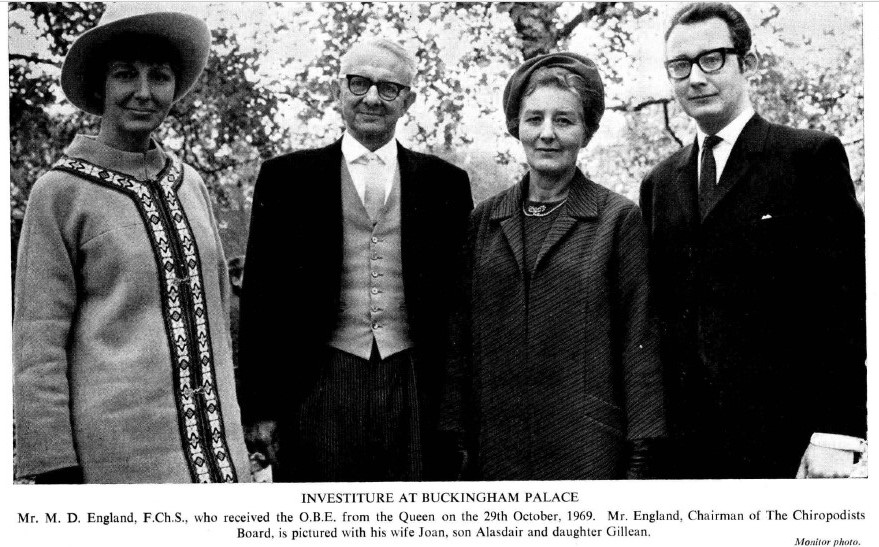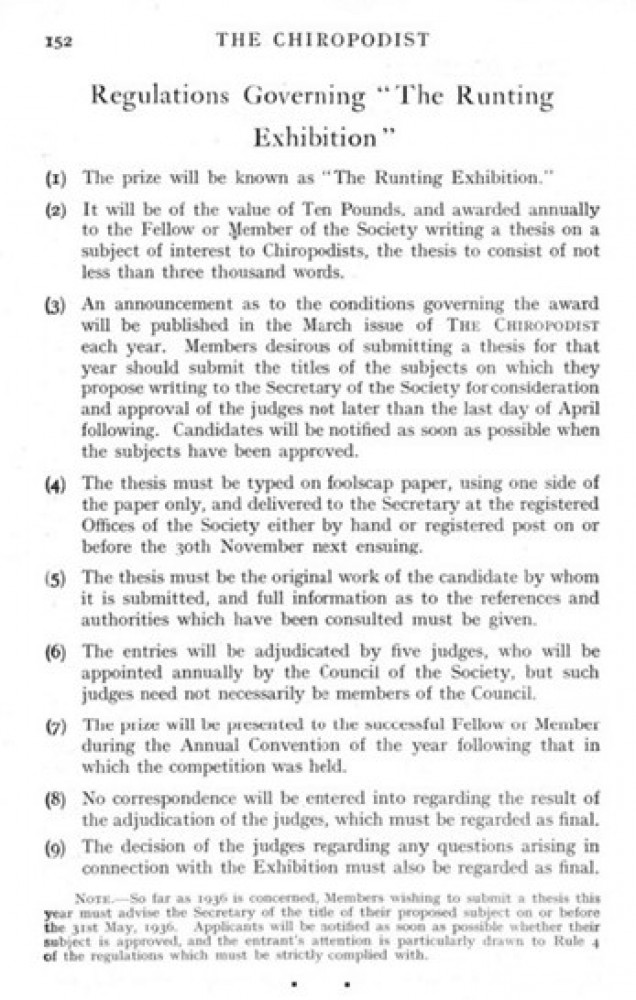The Runting Exhibition

(Suggested text: As we relaunch our awards and prizes programme, we take a look back at one of the earliest awards and find out how an article on Sasquatch or Bigfoot came close to winning the prize.)

Some form of the Runting Prize came into existence in 1915 when founder Ernest V Runting (pictured, left) donated £100 in ‘War Bonds’ for students who gained the highest honours in examinations.
Subsequently, this fund was transformed and given the name ‘The Runting Exhibition.’ This was intended to reward a thesis of 2,500 + words in a subject of interest to chiropodists. The overall vision behind this award was
‘advancing and encouraging the study of chiropody in the UK.’
In 1936, the rules governing the award were as follows:
From then on, a version of these rules was published in The Chiropodist and subsequent publications at the beginning of the year, usually during March.
The award was granted at the behest of a committee which included many of the Society’s governing committee as well as respected chiropodists. These included John Hanby, Charles Kemp, Norman Lake, Donald Neale, Peter Read, Henry Rosenstein, H E Walker and Margaret Witting.
At many points, throughout its existence the prize fund was increased in an attempt to entice entrants. The first prize awarded was £10, in 1987 it stood at £200. In 1979, double award winner, H.G. du Pasquier Gillett gave a gift to the Exhibition which doubled the prize pot. The status of the Runting Exhibition fund was routinely mentioned in the annual accounts and printed in the journal. The value of the Runting Fund increased from £268 in 1946 to £5,499 in 1993.
There were only 11 winning theses during the existence of the award. The majority of these were then published in subsequent editions of The Chiropodist.
However, most years there were either no submissions or those considered were not deemed to be of sufficient quality. On several occasions, a compensatory award was given; this included a mention to W.G. Smith for his 1991/92 submission The Anatomy and Gait of the Sasquatch or 'Bigfoot'!
| Year | Author | Title |
| 1937 | John Nicolle Le Rossignol | Some Conditions of the Epidermis met with in Chiropody |
| 1938 | D H Cadman | The Evolution of the Human Foot |
| 1940 | Miss D M Froude and W Dayton-Lewis | Award divided between Psychology and Chiropody by Froude and The Present and Future Status of Chiropody by Dayton-Lewis |
| 1953 | Walter Seelig | Studies in the History of Chiropody: 17th and 18th century |
| 1955 | John Darge Stewart | Spread foot |
| 1958 | O T Vincent | Observations on the Incidence of Foot Disorder in Children |
| 1972/73 | H G du Pasquier Gillett | Dorsal Digital Vascular corn - treatment and prognosis |
| 1978/79 | H G du Pasquier Gillett | Hallux Valgus and the Bowstring action of the Extensor and Flexor Tendons of the Great Toe |
| 1980/81 | J C Dagnall | The history, Development and Current status of Nail Matrix Phenolisation |
| 1986/87 | Ms J Drysdale | Standing Still: A Stabilomatic Study into Age, Blindness and the Stability of Stance |
| 1987/88 | W G Smith | The Reciprocal Influence of Selection and Pleiotropy in the Evolution of the Human Hand and Foot - a review |
This lack of submissions does seem to have been a theme running through the years of the award’s existence. Could this have been because the rules attached to the award were too stringent or the prize fund too low? For a number of years, the committee did not make an award despite entrants but did make a compensatory payment. Did this mean the judging panel were too stringent or submissions were not of sufficient quality?
This lack of interest was addressed periodically in The Chiropodist, which commented on the situation and attempted to resolve it. In 2003, Podiatry Now reported the Council had discussed ways in which to promote the award.
In 2009, it appeared to have been amalgamated with other awards to become the ‘Ernest Runting Podiatry Research Fund’ and in 2015, an award was made under this banner to Dr Lisa Farndon entitled Current Patient Population Managed by UK Podiatrists… and Evidence to Support the Effectiveness of Podiatry to Health and Well-being. Unfortunately, the Runting Exhibition/Research Fund was quietly sidelined during the late 2010s – the perennial lack of submissions undoubtedly proved to be an insurmountable challenge.
Find out more about Ernest Runting
(Top image: our leading image shows M D England, one of the Runting Exhibition judges, pictured after receiving an OBE in 1969)
